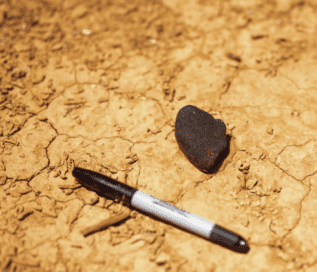
Scientists in Western Australia have carried out the first recovery of an observed meteorite fall with the help of drones and machine-learning techniques. The finding could pave the way for more falls to be located and studied, helping scientists explore the make-up of the asteroid belt between Mars and Jupiter (arXiv:2203.01466).
The discovery was made after a bright meteor fireball was spotted in April last year by cameras belonging to the Australian Desert Fireball Network. Following examination of the fireball, researchers determined that meteorites could have been scattered in an area near to Kybo Station in Western Australia. A team was then deployed to the predicted “strewn field” to begin searching the area using two drones.
The fireball analysis indicated that the mass of the fall was “quite small”, according to Ellie Sansom from the Space Science and Technology Centre at Curtin University, who is project manager for the Desert Fireball Network. “This was an excellent candidate to test our new drone detection techniques as we would have been unlikely to ever send a human team to this fall site,” she adds.
One drone photographed swathes of the landscape with a high-resolution camera. Its images were then loaded onto a computer running a machine learning algorithm that had been trained to look for unusual objects lying on the ground. The team also placed known meteorite specimens in view of the drone, so that the system could see what these looked like against the actual landscape being scoured for the new fall.

Candidate meteorites were identified before another, smaller, drone was sent for a closer look, flying low over the potential space rocks to allow the researchers to examine them more carefully. Eventually the list was whittled down to just four objects, which the team inspected on foot.
Among them was the 70 g meteorite. “There were about 10 seconds where I didn’t believe it and needed to take a hard look to confirm, followed promptly by about two minutes of screaming,” says Seamus Anderson, who led the Curtin University study.
Early analysis suggests the meteorite may be a chondrite-type meteorite whose past orbit took it far beyond Mars towards the orbit of Jupiter. The team is now planning to examine the space rock’s composition with a range of equipment including a scanning electron microscope.
A ‘game-changer’
Locating a newly landed meteorite marks an important moment for a cutting-edge technology that several teams around the world have been trialling in recent years. Last year a US-led group revealed how they had been testing a similar drone-and-machine-learning system to hunt for meteorites that they had placed on a dried-out lakebed in Nevada.
The leader of that study, Robert Citron at the University of California Davis, says the Curtin University team have made a “huge leap” through the discovery of a freshly fallen meteorite fragment. “As technology becomes cheaper and more readily available, it can be more accessible to other individuals or groups wishing to perform such studies, increasing the overall recovery of meteorites worldwide,” he says.
That is echoed by Martin Suttle, a meteorite expert at the UK’s Open University. He describes the technology as a game-changer. “Researchers rely on the recovery of new meteorites,” he says. “To be able to increasingly automate this process, reducing the number of researchers needed in big fieldwork expeditions, will bring the costs of searching down.” That, Suttle argues, will allow planetary scientists to not only look for more meteorite falls but also dedicate more time to the scientific analysis of those that are retrieved.
And more recovered space rocks — whose orbits, and therefore origins, can be determined because their falls have been detected by multiple cameras — means more data too. Suttle explains that the context provided by such information is vital. “Over time, this means we are able to build up a picture of which asteroid families are sending rocks to Earth and ultimately the composition and structure of the asteroid belt itself,” he says.



